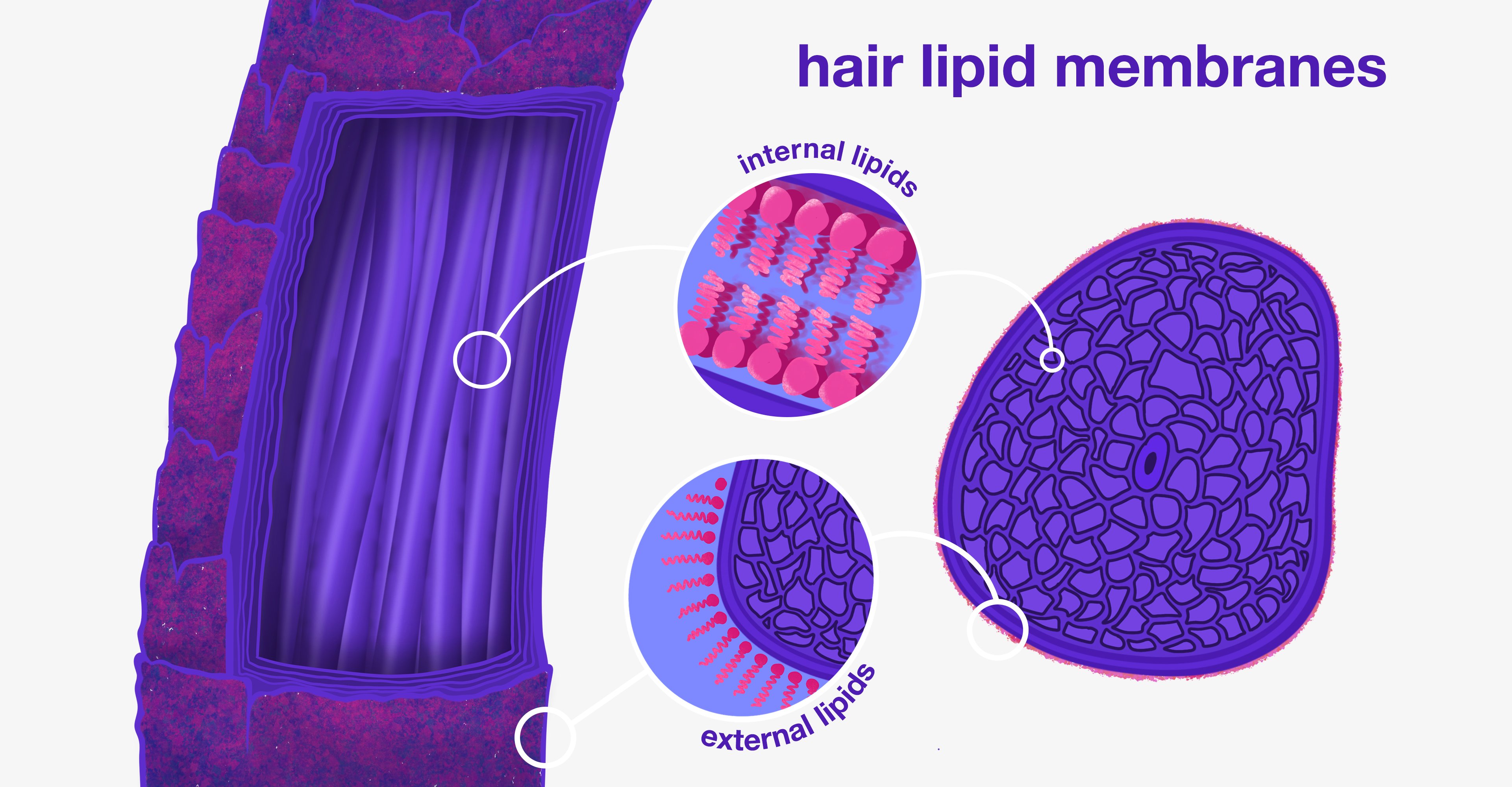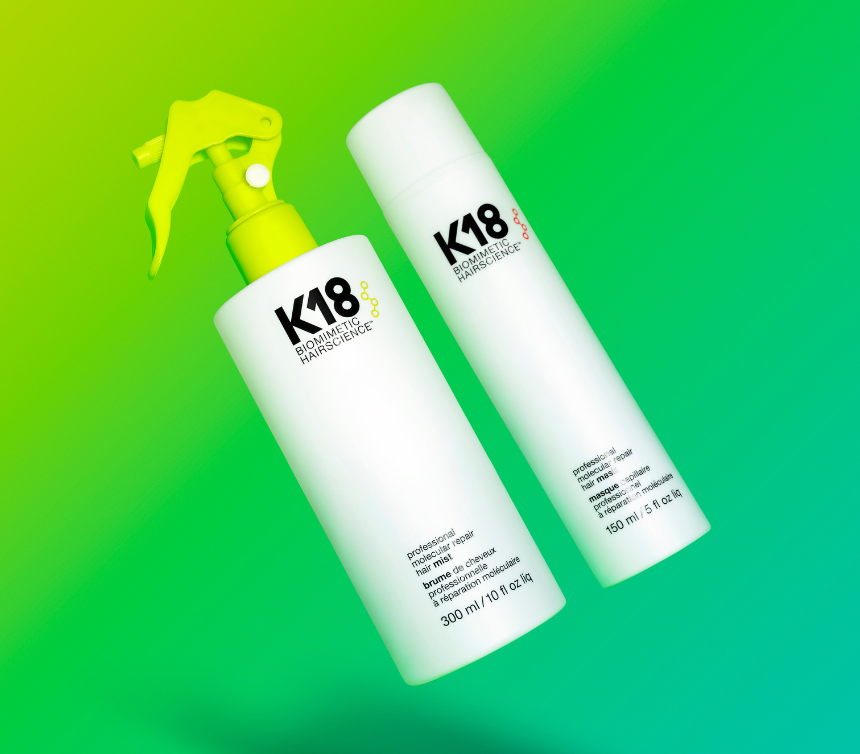We often talk about the keratin protein structure of your hair (because that’s what our K18PEPTIDE™ repairs) but your hair isn’t all protein. In addition to water, minerals and pigments, lipids—fatty, waxy, oily substances that naturally condition, protect, and maintain optimal moisture balance—are also found inside and on the surface of hair and play an important role in hair health. These can act as the first line of defense against aggressors like chemicals and heat.
Today, we’re showing some love to these lipids, diving into their function in hair’s structure, how they relate to heat damage, and why K18 molecular repair hair oil is the ideal way to protect against heat and lipid loss.
hair isn’t just protein
Hair is a multilayered structure made up of mostly proteins, predominantly keratin. The outermost layer is called the cuticle. The cortex layer lies under the cuticle and is made up of keratin proteins that form long chains. These chains weave together like threads in a rope to make your hair stronger.
Proteins have a starring role in supporting the strength and elasticity of your hair, but 2 to 6 percent of hair’s weight is made up of lipids.
the function of hair lipids
Lipids act as a shield to protect the inside of your hair from the outside environment, keeping foreign substances out and the right amount of moisture in. Your hair has both surface and internal lipids that serve distinct functions.

Internal lipids—like cholesterols, ceramides, fatty acids, and cholesterol sulfate—are produced by tiny organs in your scalp called follicles. These lipids join forces to protect hair and lock moisture in while maintaining shine, elasticity, and strength.
Your hair also has a surface layer of lipids, predominantly 18-methyleicosanoic acid (18-MEA), bound to cuticle proteins that act as a natural barrier to shield hair from the outside environment.
Important glands within hair follicles of your scalp produce protective natural oils called sebum. Sebum coats the hair fiber as it grows and provides natural conditioning by giving hair “slip,” which means less friction between strands, preventing damage when they come into contact with each other.
Lipids are an important component of hair. When the hair loses its internal and external lipids, it loses smoothness and shine. Your hair also becomes more susceptible to absorbing water. When water passes through your cuticle, it disrupts the temporary hydrogen bonds between the keratin chains in your hair, causing frizz and weakening hair’s structure. Heat damage also can strip away your hair’s lipids and break down its protein structure.
so, what causes heat damage?
Hairdryers, straighteners, and curling irons use heat to reform temporary chemical bonds in your hair, changing its shape until the next wash. But too much heat can damage your hair structure, making it dull, dry, and brittle.
The cuticle is the most heat-resistant part of your hair and can withstand heat until it reaches temperatures greater than 482°F (250°C). Heat damage causes your hair’s outer cuticle cells to lift and separate creating holes and leading to dullness and tangling. Using heat tools on wet hair is even worse—it makes large quantities of water evaporate rapidly, which can cause chips, cracks, and bubble-shaped bumps in your hair.
At temperatures above 392°F (200°C) the proteins in the cortex of your hair begin to break down in a process called denaturation, degrading structure and decreasing your hair’s strength and elasticity.

When your hair has pre-existing damage from chemical services like bleaching, perming, and relaxing which also strip away the lipids in and on your hair, your hair will experience even more damage when coupled with heat.
how oils can protect from heat damage + lipid loss
While it may sound counterintuitive, oils can help protect from heat damage + lipid loss in many ways.
To start, they help regulate your hair’s moisture content. By creating a water-disliking barrier on the fiber surface, it slows diffusion of environmental water molecules into the hair fiber that contribute to frizz while also reducing the extreme loss of water in very damaged hair that can make it brittle. A small amount of water present in hair acts as a heat sink, providing additional thermal protection by absorbing heat and reducing the amount experienced directly by hair proteins.
It’s important to note that not all oils are created equal. Some emollients like squalane, hemisqualane, or caprylyl caprylate/caprate are made up of only one or a small number of chemical compounds, meaning they will have specific and reproducible properties like smoke point (aka heat resistance).
Natural oils, on the other hand, contain a mixture of different compounds that can vary somewhat depending on their source. Due to this unique chemical composition, different oils will have distinct general properties. The majority of vegetable oils will have constituents that prefer to associate on the hair fiber surface, providing primarily water-repellency and lubrication as mentioned above. A select few oils, including sunflower and coconut oils, have the right composition that allows them to penetrate into the hair fiber, which may add to the internal protection of hair’s cortex proteins.
While sebaceous lipids are continuously generated by the scalp, internal and surface-bound lipids cannot be replaced once they are lost. That means preserving those already in hair is super important.
Many oil products on the market create a temporary fix to smooth hair and alleviate frizz by mimicking the role of natural lipids temporarily—but this isn’t getting to the source of the problem.
the molecular repair difference
The key to preventing damage and lipid loss is choosing an oil that protects hair from heat by providing a barrier between the hair and heat tools, preventing hair fibers from experiencing as much direct contact with elevated temperatures.
K18 molecular repair hair oil repairs damage from the inside out with our patented K18PEPTIDE™, which reconnects broken bonds in hair’s structure to restore lost strength and elasticity the molecular level*
Our hair oil also contains avocado oil, an ingredient known for its high smoke point of 520°F (271°C) as well as squalane and hemisqualane, ingredients shown to defend against heat damage at temperatures up to 450°F (232°C) without making hair feel heavy. We selected sunflower oil for the formula because it’s one of few natural oils indicated in literature to diffuse into the hair fiber. This synergistic formula repairs damage while protecting against future heat damage.
-v1722027961333.jpg?3840x2000)
Another way K18 hair oil prevents damage is by lubricating hair strands, decreasing friction, and increasing “slip” during straightening and brushing while blow-drying. This helps hot tools glide more easily by spreading heat more evenly to reduce targeted damage. The oils used in our hair oil also regulate your hair’s moisture content which allows hair to better absorb heat without changing temperature, reducing heat damage.
The best part? Thanks to biotech, you don’t have to choose between deep molecular repair and surface heat protection—our oil does it all.



